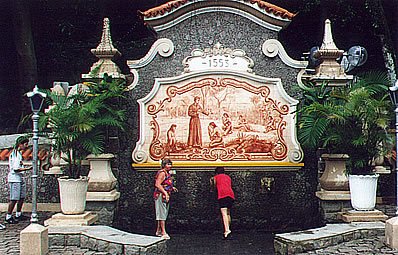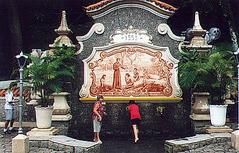
Visiting Biquinha De Anchieta: Hours, Tickets, and Historical Significance in Cubatão, Brazil
Date: 16/08/2024
Why Visit Biquinha De Anchieta?
Nestled in the heart of São Vicente, Brazil, Biquinha de Anchieta stands as a testament to the rich cultural and historical tapestry of the region. This historical fountain, named after the Jesuit priest Father José de Anchieta, has been a cornerstone of local heritage since the early 16th century. The site not only served as a crucial water source for early settlers but also became a focal point for Jesuit evangelization efforts and cultural activities (Revista Nove). Over the centuries, Biquinha de Anchieta has undergone various architectural transformations and faced numerous challenges, including acts of vandalism and the need for restoration. Today, it remains a cherished landmark, drawing visitors from around the world who seek to immerse themselves in Brazil’s colonial past and cultural legacy.
Table of Contents
- Introduction
- History of Biquinha de Anchieta
- Visitor Information
- Nearby Attractions
- Cultural Significance
- Modern-Day Relevance
- Educational Impact
- Preservation Efforts
- Frequently Asked Questions (FAQ)
- Conclusion
Introduction
Nestled in the heart of São Vicente, Brazil, Biquinha de Anchieta is a historical and cultural landmark that offers a fascinating glimpse into the country’s colonial past. From its early beginnings to its modern-day relevance, this site holds immense significance for both locals and tourists. In this guide, you’ll find everything you need to know about visiting Biquinha de Anchieta, including its history, visitor information, travel tips, and more.
History of Biquinha de Anchieta
Early Beginnings
Biquinha de Anchieta, located in São Vicente, Brazil, is one of the oldest and most historically significant water sources in the country. The earliest records of the site date back to between 1515 and 1520, when it was known as the “Fonte do Povoado” (Revista Nove). This period predates the arrival of Martim Afonso de Souza in 1532, making it a crucial landmark in the early colonial history of Brazil.
The Role of Cosme Fernandes
During the early 16th century, the area around the Biquinha was inhabited by the Portuguese exile Cosme Fernandes, also known as the Bacharel de Cananeia. Fernandes played a significant role in the local community, utilizing the water from the Biquinha and another nearby source known as the “Fonte dos Padres” (Revista Nove). These sources were essential for the survival and development of the early settlements in the region.
The Arrival of the Jesuits
The Biquinha gained further prominence with the arrival of the Jesuit missionaries in the mid-16th century. Notably, Father José de Anchieta, a key figure in the Jesuit mission in Brazil, used the site for meditation, catechism classes, and theatrical performances (ResJero). Anchieta’s activities at the Biquinha are considered by many to be the origins of theater in Brazil, as he staged religious plays, known as “autos,” which were attended by both the local populace and colonial authorities.
Architectural Evolution
The Biquinha de Anchieta has undergone numerous architectural changes since its initial construction. The first significant structure was a rudimentary wall built by Anchieta himself. Over time, this was replaced by a more elaborate Portuguese mosaic depicting Anchieta’s mission among the indigenous people (Revista Nove). This mosaic was later substituted by a terracotta high-relief work, inaugurated on January 22, 1943, to commemorate the 411th anniversary of São Vicente’s founding (ResJero).
Depredations and Restorations
Despite its historical significance, the Biquinha has faced numerous challenges, including acts of vandalism. The terracotta high-relief, for instance, suffered severe depredations, necessitating its replacement with a new mosaic that remains in place today (ResJero). The site has also undergone several restorations to preserve its historical and cultural value, the most notable being the comprehensive renovation in 1850.
Visitor Information
Opening Hours and Tickets
Biquinha de Anchieta is situated in a public square (Praça da Biquinha) in the center of São Vicente, making it easily accessible to visitors. The site is open to the public without any restricted visiting hours, allowing tourists to explore its historical and cultural significance at their leisure. There is no entry fee, making it an ideal destination for budget-conscious travelers.
Travel Tips
- Best Time to Visit: The best time to visit is during the dry season, from May to September, when the weather is most pleasant.
- Getting There: São Vicente is well-connected by public transportation, and the Biquinha is within walking distance from most central locations.
- What to Wear: Comfortable walking shoes are recommended, as you may want to explore the surrounding areas.
- Guided Tours: While there are no official guided tours, local guides are often available to provide historical insights.
Nearby Attractions
- Historical Center of São Vicente: Explore more of the city’s history with a visit to the nearby historical center.
- Beaches: São Vicente boasts beautiful beaches perfect for relaxation and water activities.
- Museums: Visit local museums to further enrich your understanding of the area’s cultural heritage.
Cultural Significance
The Biquinha de Anchieta is not just a historical site but also a cultural landmark. It features a mosaic in azulejos (Portuguese tiles) that romantically depicts Anchieta catechizing the native peoples (Wikipedia). The fountain itself has three lion-shaped spouts, adding to its aesthetic appeal. The surrounding area, known for its scenic beauty, has been a place of public gatherings and theatrical performances since the time of Anchieta.
Modern-Day Relevance
Today, the Biquinha de Anchieta is a cherished landmark that continues to draw visitors. The presence of a life-sized statue of Father Anchieta further enhances the site’s historical ambiance.
Educational Impact
The Biquinha de Anchieta also serves an educational purpose. Near the site, the Jesuits established the Colégio dos Meninos de Jesus de São Vicente, which played a crucial role in the early education of the local population (Revista Nove). This institution was instrumental in teaching catechism and the basics of the Portuguese language, thereby contributing to the cultural and educational development of the region.
Preservation Efforts
Efforts to preserve the Biquinha de Anchieta have been ongoing. The site is listed under various heritage preservation statutes, including the CONDEPHASV, as per Decree No. 3354-A dated August 12, 2011 (ResJero). These measures ensure that the site remains protected for future generations to appreciate its historical and cultural significance.
Frequently Asked Questions (FAQ)
- What are the visiting hours for Biquinha de Anchieta? The site is open 24/7 with no restricted visiting hours.
- Is there an entry fee for Biquinha de Anchieta? No, there is no entry fee.
- Are guided tours available? While there are no official guided tours, local guides often provide historical insights.
Conclusion
The Biquinha de Anchieta stands as a testament to Brazil’s rich colonial history and cultural heritage. From its early use by local populations and Portuguese exiles to its role in the Jesuit missions and the development of Brazilian theater, the site encapsulates a wide array of historical narratives. Its architectural evolution, cultural significance, and ongoing preservation efforts make it a must-visit landmark for anyone interested in the history of São Vicente and Brazil as a whole.
Call to Action
Plan your visit to Biquinha de Anchieta today and immerse yourself in Brazil’s rich history. Don’t forget to check out other related posts and follow us on social media for more updates!
References
- Revista Nove, 2024, Author source url
- ResJero, 2024, Author source url
- Wikipedia, 2024, Author source url
- Brazilian Coast, 2024, Author source url
- Wanderlog, 2024, Author source url
- NASA Climate Data, 2024, Author source url
- Hofstede Insights, 2024, Author source url

